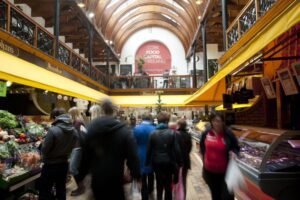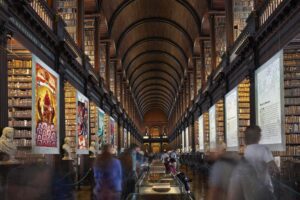Ancient Roots, Modern Magic
Three cities of Ireland’s Ancient East
Most of Ireland’s cities and larger towns are in the east, facing the Irish Sea and the island of Britain. Trade with our larger neighbour was the east coast’s lifeblood for centuries, and the cities of Dublin, Waterford and Cork, as well as important port towns like Rosslare and Wexford have historically been vital hubs for the movement of people and goods. Unfortunately, environmental and economic changes – and a lack of infrastructural investment – have meant that a lot of formerly bustling ports became shadows of their former selves during the 20th century…but many have taken up the slack by concentrating on tourism, which is excellent news for explorers of Ireland’s Ancient East!
The majority of the larger settlements on the east coast were founded by the Vikings, sometimes in places where the native Irish had set up smaller, more scattered settlements, as in the case of Dublin, or where there was already a small monastic settlement, as happened in Cork. Those older settlements themselves sometimes grew at places which had been inhabited for millennia, as is the case in the beautiful seaside town of Youghal, in County Cork: the earliest inhabitants lived there in the Neolithic, about 5000 years ago. A church and an associated ecclesiastical settlement were in place by the 6th century, and the Vikings established the nucleus of the modern town about five centuries later.
Successive layers of heritage, from monks to Vikings, to Norman and British landowners, to modern links with Britain and Europe, have given the towns and cities of Ireland’s Ancient East a distinctive character, with layer upon layer of history evident in everything from the layouts of streets to the architecture, place names and even the local traditions and accents. This has resulted in vibrant, welcoming, interesting, fun destinations for the 21st Century explorer to see!
Dublin:
Ireland’s capital and by far its largest city, Dublin (Baile Átha Cliath in Irish; the town of the hurdle ford…see Page ::::) wears its ancient heritage on its sleeve even as it’s become a modern, exciting European city. Nearly one in every four Irish people lives here, and in recent years the city has also become a melting pot for the newest members of the Irish family, who have arrived from all over the world and are proud to call the city their home. Dublin is a city of contrasts, and the ancient, narrow, twisting streets of the heart of the old city give way to wide, tree-lined Georgian and Victorian avenues in the space of just a few metres.
Dublin is home to a vast array of cultural experiences: here you can find food from all over the world in the capital’s thousands of restaurants, to refuel as you explore the museums, art galleries, and ancient buildings which show so much of the city’s history.
A short stroll will take you from Christ Church Cathedral, founded by the Viking warrior Sitric Silkenbeard, to the famous Temple Bar, popular for its legendary pubs and nightlife.The Phoenix Park is an enormous green space of 1750 acres, beginning just a short stroll from the city centre. Its size alone marks it out as special, as it’s one of the largest parks of its kind in Europe. The Phoenix Park is home to Dublin Zoo, as well as Áras An Úachtarán, the home of the President Of Ireland. Dublin is also famous as the home of Guinness, one of Ireland’s most famous contributions to the world, and no visit is complete without a tour of the Guinness Storehouse, one of Ireland’s most popular tourist attractions, where you can learn more about “the black stuff” and its history in Ireland and abroad.
Check it out…
While in Dublin, check out the incredible library at Trinity College, Dublin, an inspiration for the creators of the Star Wars and Harry Potter movies and home to one of the world’s most incredible collections of books…including the Book Of Kells, one of the world’s most famous and precious works of art. Then make your way to Temple Bar for a drink and to experience the live music and energy of this popular area! For a taste of real a real Dublin pub you can’t beat The Long Hall on South Great George’s Street, one of the country’s oldest and finest establishments, and a second home to poets, singers, writers and artists of note. No tvs, no bar food, no children allowed…this is an old school pub experience in a setting which hasn’t changed in well over a century. Fans of fine dining should make a point of visiting the phenomenal Restaurant Patrick Gilbaud, the only restaurant in Ireland with two Michelin stars. You’ll find it at the beautiful Merrion Hotel. Reservations are advised!
Waterford
Waterford is Ireland’s oldest city, founded by the Vikings in the year 853. It remained their stronghold for nearly a century until the native Déise tribe defeated them, but that Irish victory was short lived, and the Vikings returned in the early 10th century under Ottar and Ragnar, and built a heavily fortified town. 160 years later, in 1170, Waterford would become the first city to be conquered by the Normans, who arrived here at the invitation of Diarmuid Mac Murchada (Dermot MacMurrough), who wanted them to help him claim kingship over Ireland. Diarmuid, who had been deposed as King of Leinster for kidnapping the Queen of Breifne, made a deal with the Welsh Norman Lord Richard de Clere, nicknamed “Strongbow”.
In return for his help in subduing Diarmuid’s enemies, Strongbow would be granted the hand of Aoife, Diarmuid’s daughter, in marriage and would become the ancestor of the future kings of Leinster. The invasion was a success, and Strongbow and Aoife were married in Reginald’s Tower, a Viking bastion which still stands at the very heart of Waterford City and is today a must-see museum. One year later, in 1171, King Henry II of England, fearful of Strongbow’s new-found power in Ireland, set sail for Waterford, setting the stage for centuries of English domination over Ireland.
BOX: Reginald’s Tower is the oldest continually used civic building in Ireland, and is believed to have been the very first building in Ireland to have been built using mortar. It’s also the only civic building in the country to have retained its original, Viking name. It is the most famous of a network of Viking towers which still stand in Waterford, and are among the best examples in the world of medieval town defences. As well as serving as the site of the wedding of Strongbow and Aoife, it has been used as a mint, a magazine, and a prison, and was briefly home to King John, nemesis of Robin Hood, in the 13th century. A cannonball is visible embedded in the tower’s walls: it was fired from one of Oliver Cromwell’s cannon when he besieged Waterford in 1650. Local legend has it that King James II scaled the tower to stand on its roof and look out over Ireland one last time before leaving for exile in France following his defeat at The Battle Of The Boyne in 1690.
Check it out…
Waterford provides a wealth of experiences for young and old. The Waterford Treasures Medieval Museum should be near the top of anyone’s list; this eye-catching building contains a trove of incredible artifacts and amazing exhibits which bring the city’s remarkable history vividly to life, including genuine medieval clothing, ancient maps, weapons and equipment. The museum itself is a historical artifact, and encompasses buildings from the 13th and 15th centuries! The Waterford Crystal Visitor Centre focuses on the city’s world-famous crystal, including breathtaking displays of rare examples, the crystal’s incredible production process, and the painstaking art and craft of making some of the world’s most beautiful and sought-after pieces. Walkers and cyclists alike are well catered for, especially with the Waterford Greenway, which tours the stunning Copper Coast all the way to the vivacious town of Dungarvan. Nearby is the Comeragh Drive, which takes you through the beautiful Comeragh Mountains and reveals some of Ireland’s hidden scenic treasures.
Cork
Cork City is nestled between the steep sides of the Lee Valley, built over a network of islands in the marshy land at the mouth of the Lee. Some branches of the river still flow under the city streets, and modern visitors can still see old mooring posts and water gates leading today to paved streets in the city centre showing just how recently the river was covered up.
Cork is Ireland’s second largest city, and its residents good-naturedly describe it as “The Real Capital”. It’s also known as The Rebel City, and Corkonians are proud of their distinctive history. A very strong French Huguenot influence left its mark on Cork’s attitude, cuisine and even the oft-lampooned local accent and slang, and it’s not uncommon for even other Irish people to be left behind when listening to a Corkonian conversation in full swing.
The heart of Cork is situated on Morrisson’s Island, sandwiched between the two remaining overground branches of the River Lee, but the city has long spread out over the sides of the valley, and now extends up and down the harbour. Cork’s mixed heritage is echoed today in its wide variety of places to go and things to do, and the city is full of enchanting nooks and crannies, art galleries, cultural hotspots, theatres, exceptional pubs and restaurants and inviting, beautiful green spaces, especially towards the western end, where the grounds of University College Cork, Fitzgerald’s Park and the Lee Fields provide ample opportunity to slow down and step away from the busy streets. The city has a vibrant and thriving nightlife, and an outstanding local music scene, and you can find everything from traditional Irish music sessions to jazz and blues, storytelling nights, comedy clubs, plays, street performances, swing dancing and much more.
The busy city centre is long and narrow, and enclosed by St Patrick’s Street, a long, S-shaped thoroughfare built over a channel of the Lee, and the long, straight St Oliver Plunkett Street. Between the two, you’ll find everything from artisan coffee houses to curiosity shops, bars of all shapes and sizes and ages, hidden gems of restaurants serving everything from traditional Irish food to exceptional world cuisine, and Cork’s famous English Market, heaven on earth for foodies. The English market is Cork’s go-to place for everything from fresh, locally-caught fish to fine wines, world cuisine, outstanding cheeses and organic produce, adventurous new fusions and more. At the other side of St Patrick’s Street is the Huguenot Quarter, a haven for oppressed French Protestants who fled here to escape persecution following in their homeland. It’s a warren of little streets branching off towards the Lee, filled with myriad shops and restaurants.
Check it out…
Cork is an ideal base for exploring the southern part of Ireland’s Ancient East as well as an exceptional destination in its own right. Beer lovers should check out The Franciscan Well on North Mall, one of Ireland’s oldest microbreweries and makers of world-famous prizewinning beers. Vegetarians and meat-lovers alike will be blown away by the incredible meat-free fare of Café Paradiso, on the Western Road. Explore the Stone Corridor and gorgeous riverside grounds of University College Cork, and be sure to visit the museum at nearby Fitzgerald’s Park for a look back through millennia of Cork’s history.




